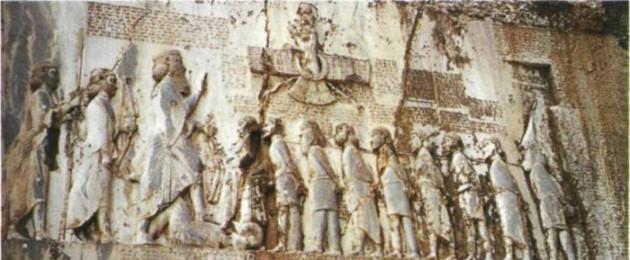Studying a culture that has left no written sources is like interrogating a mute and, moreover, an illiterate person. All the information received is reduced to drawings and violent gestures. Of course, you can understand something, but much less than we would like. An order of magnitude richer are the “testimonies” of a culture that had a written language and left various kinds of texts as a legacy to descendants.
It is precisely such a threshold at the turn of the 4th-6th millennium BC. e. passed ancient mesopotamia. Before that, majestic temples and powerful fortifications were already built in Mesopotamia (the second name of Mesopotamia), there was a network of canals, dams, artificial reservoirs that provided the country with water and saved it from formidable river floods, merchants went on long journeys, artisans were famous for their art and subtlety work. By that time, large settlements existed on the territory of Mesopotamia. Some scholars are cautious about calling them proto-cities, others just towns. Judging by the archaeological finds, the local population developed complex religious ideas, and also widely practiced magic. Thus, the country had all the signs except one - writing.
Finally, the Sumerian people created it. A number of scientists believe that in the entire history of mankind there was no more significant upheaval.
Semites- peoples speaking languages belonging to the Semitic branch of the Semitic-Hamitic language family. Now these are Arabs, Jews, as well as a number of other peoples. Ancient Semites - Akkadians, Babylonians, Amorites, Eblaites, Chaldeans, Arameans, and many others.
Riddles of cuneiform
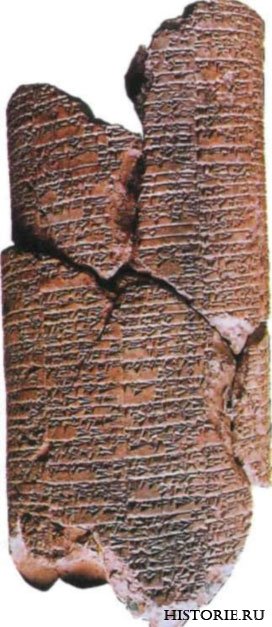
The Sumerians created writing at the turn of the II-III millennium BC. And at first it was a set of simple drawings that could only remind the reader of certain information, hint at some information, but not convey it exactly. Each figure could denote several concepts at once. The words “bring”, “come” and “go” were equal in writing to the same sign. Two or three signs could combine, giving rise to a third, completely new one. Thus, the drawings corresponding to the concepts of “lu” (“man”) and “gal” (“big”) merged into the concept of “lugal” (“master”, “lord”, “ruler”). Gradually, the number of signs grew, it became more and more difficult to memorize them. In addition, the farther, the more drawings ancient Sumerian writing lost touch with what they represent. They were squeezed out on wet clay, and it is very difficult to apply curved lines, circles on it and repeat the drawing from time to time. In the end, scribes began to use only straight lines. Their tool - a thin stick - extruded something like a wedge on a clay tablet, since it was in contact with the clay at an angle and the pointed tip went deeper. Previous drawings became an intricate pattern of small wedges. They turned into schemes that are completely different from what they were originally drawn from. This the transformation took several centuries.
The very tradition of such writing was called "cuneiform". Gradually, cuneiform charts began to be used to compose "puzzles". The Sumerian language is rich in short words of one or two syllables. And when a scribe combined a shemka denoting one concept with a shemka denoting another concept, the result could already be read as a combination of sounds, not words. Even if the resulting word was not associated with the original concepts of two or more drawings from which it was “blinded” ...
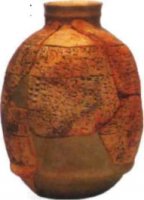
Things got complicated when the Sumerians left the historical stage, submitting to the tribes of the Akkadians (Eastern Semites). Their language and culture enriched the conquerors. Their script was adopted by the Akkadians as their own. But they could no longer compose puzzles in Sumerian, since the Akkadian language is completely different from Sumerian. An inexperienced reader could get confused in the meanings of cuneiform charts and completely lose the meaning of the text. The letter became extremely complicated, the “rebus” and “semantic” meaning of each sign in different combinations had to be memorized and interpreted depending on whether the text was intended for a Sumerian or an Akkadian ... Huge Sumerian-Akkadian dictionaries arose, and the craft of a scribe required great learning.
Elam- a country to the east of Mesopotamia, maintained close political and cultural ties with Mesopotamia (the second name of Mesopotamia). In III-I millennia BC. e. there was a highly developed civilization. For several centuries, Elam played the role of a great power.
All later varieties - Assyrian, Babylonian, etc. gravitate towards the Akkadian writing system.
In the XVIII - first half of the XIX century. n. e. Europeans were well aware of the existence of writing in ancient Mesopotamia. Many clay tablets with cuneiform texts have accumulated in museums and private collections. But no one could read them for a long time. Only the joint efforts of scientists from different countries contributed to deciphering. However, in the Sumerian language and Sumerian writing, scientists still do not understand everything, and translations are very approximate.
The German Georg Grotefend (1775-1853), the Irishman Edward Hinks (1792-1866), the British Henry Rawlinson (1810-1895) and William Talbot (1800-1877) at various times made efforts to unravel cuneiform writing. In addition to them, a great many other scientists worked on it with varying degrees of success.

Behistun relief. Fragment. End of the 6th century BC e.
The key to deciphering was the so-called Behistun inscription. At the end of the VI century. BC e. she was carved Persian king Darius I on the rock Bisutun (or Behistun) near the modern city of Hamadan. The inscription tells about the main events in the Persian state in three languages: Assyrian, Elamite and Old Persian. The inscription is decorated with a relief: King Darius trampling a rebel with his left foot. The winged god of the Persians Ahuramazda hovers above the images of people. The inscription and relief are truly enormous. They are visible from afar. However, it was not possible to copy the inscription for a long time, since it was located at a height of one and a half hundred meters, and serious errors could creep into the work of the copyist due to the large distance.

In 1844, Henry Rawlinson (photo on the left), obsessed with the secrets of the Ancient East, climbed a narrow ledge onto a rock and nearly fell off. For some time he hung over the abyss. Rawlinson's life could be cut short every second, he was saved by a miracle, but the Englishman did not lose his enthusiasm. He and his companions built a special bridge, which made it possible to get to the inscription and copy most of it. But Rawlinson, with all his skill and courage, did not dare to get to the Assyrian, the most distant and inaccessible fragment. And even experienced climbers did not dare to do this. Only an unknown boy from the locals made an extremely dangerous climb for a lot of money and brought down the last fragment of the inscription...
Experienced orientalists spent many years deciphering the inscription. At first they succumbed to the ancient Persian piece of text. Then, with the help of the acquired knowledge, it was possible to translate the Elamite fragment. And finally, after an incredible effort, the scholars read the Assyrian part. Thus they have the key to the writing of ancient Mesopotamia appeared. This happened around 1850.
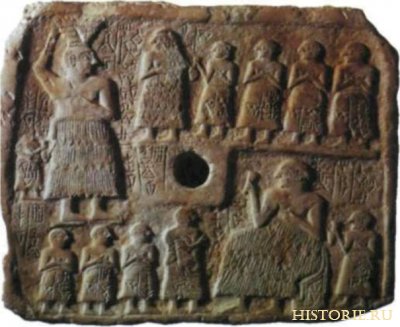
(right photo) Geological bas-relief of Ur-Nina. Limestone tablet from Lagash. Millennium B.C. e.
Unraveling the secrets of cuneiform writing has become a real scientific revolution. The hills of Mesopotamia kept an incredible number of written monuments. Clay does not rot, does not disintegrate into dust, does not burn, it cannot decay, and water will not wash away the inscriptions squeezed out on the clay firmament. Therefore, this writing material has the advantage of durability over paper, parchment, and papyrus. And what an advantage! The excavations of a single Mesopotamian city, whose name is known only to narrow specialists, gave archaeologists such a number of documents that scientists do not know for whole centuries of the medieval history of Western Europe! If you collect in the archives all the papers related to the 50-year reign of Ivan the Terrible (1533-1584) in Russia, then there will be much fewer of them than were preserved from ancient Sippar or Shuruppak ... In the archives of ancient Mesopotamia, there were tens, hundreds of thousands , and maybe millions of clay tablets. Only the palace of the Assyrian king Ashurbanipal was presented to historians 100 thousand documents! According to the English historian James Wellard, during excavations in the ancient city of Lagash, so many inscriptions were found that “the loss of about 30 thousand tablets, stolen by local residents and sold at a price of 20 cents per basket, remained practically unnoticed.” Clay archives made it possible to see in great detail the life of people 5000 years ago.
Babylon fell in 538 or 539 BC. e. But after that, Mesopotamia was not devastated, its cities were not destroyed, and the population was not destroyed. It’s just that in the future, the lands of Mesopotamia developed within the framework of another civilization - ancient Persian.
Map of Mesopotamia (Mesopotamia) - Sumerians and Akkads
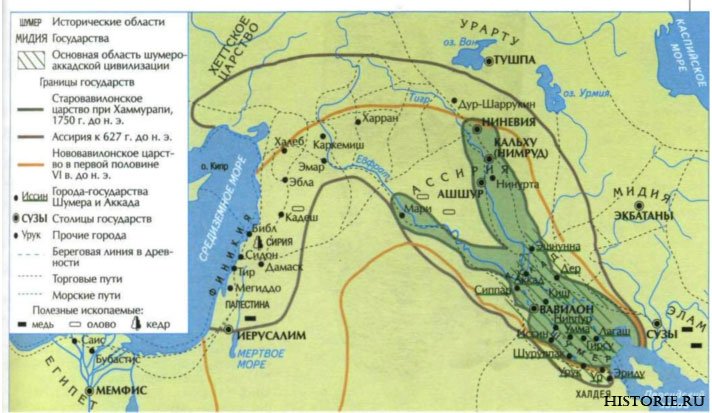
The history of ancient Mesopotamia - briefly about the 25 centuries of the history of the Akkadians, Sumerians, Assyrians
The easiest way to imagine how long and varied the fate of the Mesopotamian civilization was, turning to the numbers. If you count from the fall to the present day, the entire history of Western European civilization has just over 15 centuries. If we count from Rurik to the present day, the entire history of Russia fits into 11.5 centuries. Biography of civilization in Mesopotamia counted from the first clay tablets of the Sumerians and ends with the capture of Babylon by the Persians in the VI century. BC e. This is about 25 centuries! The history of the Sumerians alone, illuminated by written sources, took 1000 years, knew ups and downs, triumphs and tragedies...
The oldest part of the historical fate of Mesopotamia is associated with the era of small Sumerian city-states, which scientists call nomes. Here are their names: Eshnunna, Sippar, Kish, Eredu, Nippur, Shuruppak, Uruk, Ur, Atsab, Umma, Larak, Lagash, Ukushuk, Mari. Each of the nomes united a rural district and smaller towns. At the head of the nomes were the rulers - lugali and ensi. The nomes constantly fought among themselves for land and political dominance. From those times the expression remains in the sources: such and such a city was “struck by weapons”, and “its kingship passed” to the capital of the winners. A single all-Sumerian state arose for a short time under the ruler Umma Lugalzagesi in the 24th century. BC e.
Kingdom of Sumer and Akkad
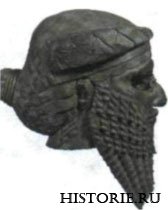
"Head of Sargon the Great" from Nineveh. 23rd century BC. (photo on the left)
Sumerian kingdom fell under the onslaught of aggressive East Semitic tribes from the Akkad region. Founder Akkadian kingdom became Sharrumken, or Sargon the Ancient. He captured Lugalzagesi and put him in a dog cage. Under Sharrumken, however, the "blackheads", as they called themselves, retained both political power and their own culture, and some nomes - and autonomous control. Moreover, the Akkadians largely adopted the culture and customs of the Sumerians, learned their script.
In the XXII century. BC e. Mesopotamia entered a period of protracted crisis. The country was ablaze with internecine conflicts. Dominance is seized by the rulers of neighboring Elam and the warlike highlanders-Kutis (or Gutii) from Western Iran. Mesopotamian civilization usually "digested" any invaders. Gradually, they themselves became part of it. But with the Kutia, things were different. They ruled the country for seven decades and aroused real hatred among the local population. Finally, ruler of Uruk Utuhengal, a legendary and heroic personality, defeated the leader of the Gutians Tirikan and took him and his whole family prisoner, thereby saving the country from the foreign yoke.
Mesopotamia was again united, arose common Sumero-Akkadian kingdom with its capital at Ur. The ruling dynasty was Sumerian, and Sumerian culture is experiencing its heyday, short-lived, but bright. However, the ancient people of the Sumerians are gradually dissolving into the boundless Semitic mass, giving way to it. When the threat of a new invasion, the Amorite nomads, looms over Mesopotamia, the "kingdom of Sumer and Akkad" does not find enough strength to fight back. The last Sumerian ruler, Ibbi-Sin, makes a desperate and tragic effort to save his state. However, in 2003 BC. e. Ur fell, and the king himself was put in chains. The Blackheads are leaving the political scene. However, this did not mean a catastrophe for the Mesopotamian civilization. It continues to develop, only on a Semitic basis.
Subsequently, the territory of Mesopotamia was repeatedly invaded by nomadic and mountain tribes: Arameans, Hurrians, Kassites, Chaldeans... However, they did not have a serious impact on the local culture and did not cause such rejection as the Gutians.
History of ancient Assyria and the city of Babylon
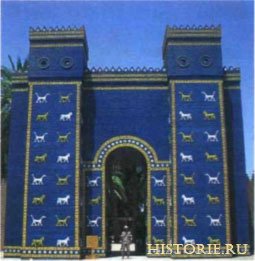
Gradually ascended two political centers of Mesopotamia. Firstly, the city of Babylon and, secondly, . The city of Babylon was fortified in the 18th century. BC e. under King Hammurabi (1792 - 1750 BC) - the great conqueror and legislator. But the Old Babylonian kingdom did not flourish for long: rebellions and wars soon undermined its strength. One and a half hundred years after Hammurabi, the Babylonian dynasty fell under the onslaught of the Hittites. The very period of the reign of the Old Babylonian rulers passed under the sign of cultural decline in the ancient Sumerian cities. However, Babylon survived the heyday twice more. For several centuries after the death of the Old Babylonian kingdom, alien Kassite tribes ruled in the country. The Kassite rulers learned to take care of the highly developed culture of Mesopotamia. Under the Kassite kings, Babylon rose again. In the XIII-XI centuries BC. e. he fights with varying success against new powerful enemies: Assyria and Elam, repeatedly suffers terrible ruin, languishes, and finally falls into the 8th century. BC e. under the rule of the Assyrians. The Assyrian kings tried to make this great city the second capital of their kingdom and granted it considerable autonomy. But even such preferential conditions of submission did not suit the Babylonians. They revolt endlessly and make treaties with the enemies of Assyria. An alliance with the tribes of the Medes brings them victory. In 626 BC. e. ruler Nabopolassar ascends the throne and establishes an independent Neo-Babylonian kingdom. Its history lasted for about 100 years. Babylon then experienced an unprecedented cultural and political upsurge. However, this did not help the city to withstand the next conqueror - the Persians...
Babylon in the era of the Neo-Babylonian kingdom of the VI century. BC. Reconstruction

- In contact with 0
- Google+ 0
- OK 0
- Facebook 0

